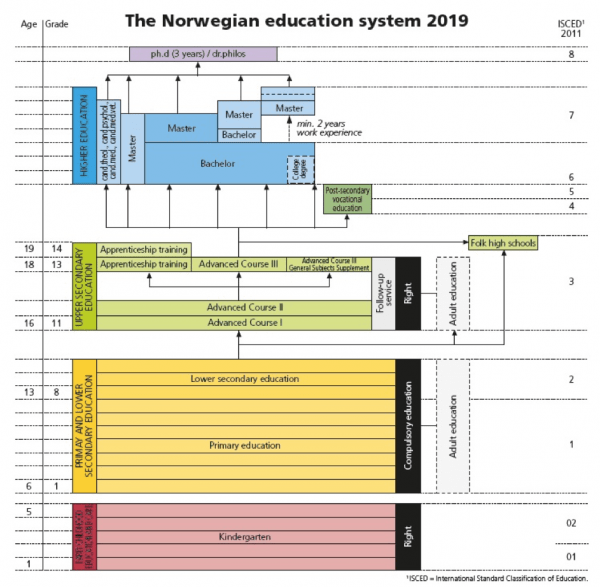Education in Norway is mandatory for all children from the age of 6 to the age of 16. Upper secondary education is not mandatory, but all young people have a right to attend 3 years in upper secondary school. The overview in the end of this article gives you an idea of the structure at the different levels.
The schools are ingeneral public and supported by the state, to ensure that access to educationis equal for all. All in all the Norwegian politicians, regardless of political party, emphasize to provide a public school of good quality and to give all people, regardless of income and social class, the same possibilities for learning and education.
A national curriculum for each subject describes what the learner is supposed to learn at each level, and all schools have to follow these curriculums regardless of being private or public.
Vocational education in our country is part of the upper secondary education system. After finishing lower secondary education, the students can choose between programs that prepare for further studies at universities or other academic institutions of education, or they can choose one of the eight vocational programs that lead to more than 180 different certificates. One of these is program for agriculture, forestry and fishing.
It is also an option to do 2 years of vocational education and then have a 3rd year that prepare you for further studies. During these 2 first years many schools (especially in Agriculture, forestry and fishing) also give you the option to choose.
Most VET programs consist of two years of school-based education and training, and then two years of apprenticeship in a training enterprise. To complete VET qualification, you have to pass a practical and theoretical exam after finishing 2 years of school and 2 years of apprenticeship.
During the two years in school the student learns common subjects like mathematics, science, Norwegian, English, social science and physical education (aprox. 12 lessons a week). There are all together 35 lessons per week, and the last 23 lessons are used for vocational subjects according to the chosen program and students choice of specialization. During the two first years at school, the student combine theoretical learning with learning by doing in school farms/workshops and placements at enterprises.
The apprenticeship period is divided between one year of training and one year of productive work for the training enterprise.
Each school year should last for 190 days. It starts in the middle of August and ends in the last weeks of June, and the school is usually closed for one week in October, one week during Christmastime, one week in February/March and one week at Eastertime.
The main challenge in our schools at time being, is that too few students finish their upper secondary education. All levels in the school system work to improve that.


